https://news.artnet.com/art-world/12-sound-artists-changing-perception-art-587054
Art World
12 Sound Artists Changing Your Perception of Art
These artists appeal to the ears, not the eyes.
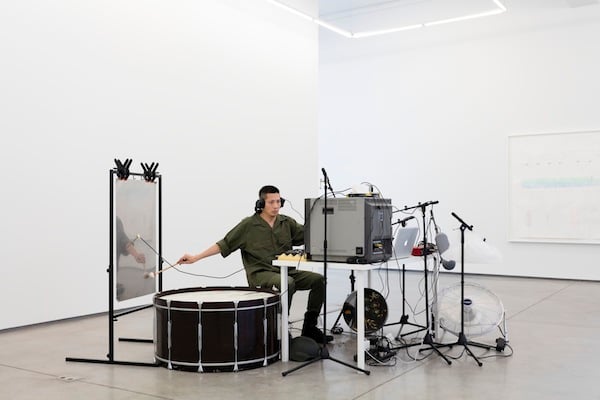
For some, abstraction might
mean non-figurative painting, but today’s hottest emotive medium is so
abstract it can’t be seen, touched, or felt. There’s no arguing that
sound art is having a moment. Some artists explore sound in its pure
state, simultaneously bridging and muddling barriers between sound,
noise, and music in the contemporary or historical sense. Others
investigate the political and cultural implications of certain sounds,
using their work to bring human rights to the fore.
Sound art is the most direct way of engaging with art—you can literally do it with your eyes closed—and if music is any indication, sound can affect your emotions immediately, without any thought or explanation.
We have compiled a list of 12 sound artists, in no particular order, expanding the way that viewers engage with art, whether through performance, installation, analogue machines, custom instruments, field recordings, or something in between.
1. Samson Young
The Hong Kong-born and based Samson Young is currently drowning the world in sound with his politically-charged performances and installations. For his first New York show in 2015, he watched six hours of compiled footage of US bombs dropping in the Middle East on mute, and then recreated the sounds of the carnage on a custom-made setup of instruments and non-instruments, like a can of compressed air, or a shaving razor. Last year, he was also added to the roster of Galerie Gisela Capitain in Cologne.
In 2016 alone, the artist is having a number of solo shows (besides his performance with sonic police weapon at Art Basel), like in Hong Kong or Kolkata, and in December, the Kunsthalle Düsseldorf will host his first European solo exhibition. Young will also represent Hong Kong at the 2017 Venice Biennale, so there’s no sign that his world takeover is stopping anytime soon.
Related: Shooting Star Samson Young to Represent Hong Kong at the 2017 Venice Biennale
2. Cevdet Erek
Cevdet Erek studied architecture and is a founding member of an experimental outfit called Nekropsi, but his art world forays are where he truly thrives. In 2012, he won the Nam June Paik award for Shore Scene Soundtrack, an interactive, ongoing project where viewers are invited to recreate the sound of the ocean by rubbing their hands on a piece of carpet. This year, he installed a site-specific intervention at the Syndey Biennal, and he will represent Turkey at next year’s Venice Biennale.
3. Carsten Nicolai
Interested in the intersection of art, music, and science, the Berlin and Chemnitz-based Carsten Nicolai has been altering audiovisual perception since the late 1980s. A co-founder of Raster-Noton, the music label for “sound and not sound,” Nicolai recently brought an installation to the Halle am Berghain.
But the artist is no stranger to more traditional art galleries: in 2016, he showed Reflektor Distortion at Galerie Eigen+Art Berlin. A basin of water reflecting a row of neon white lights was hit with low sound frequencies, altering the reflection and making sound visible.
Related: Berlin Gallery Weekend Kicks Off, Unofficially, with Raster Noton’s Berghain Installation
4. Florian Hecker
Florian Hecker creates sculptural sound installations, like his sound objects installed at Frankfurt’s Museum für Moderne Kunst (MMK) in 2010. Speakers hung from the ceiling with curved mirrors not only reflected the look of the sounds’ source, but altered the atmospheric sounds’ waves as well. The artist is also interested in a concept he calls “chimerization,” like his projects at Documenta 13 or his collaboration with Mark Leckey, where he manipulates voice recordings to create glitchy compositions.
In November, the MMK will welcome Hecker back for “Formulations.” The same month, Vienna’s Kunsthalle will open an exhibition of synthetic sound compositions: “Halluzination, Perspective, Synthese.“
5. Susan Philipsz
The first sound artist to win a Turner Prize, Susan Philipsz creates audio collages using recordings of her own voice and samples from an eclectic range of musical inspirations, from Irish folk music to David Bowie. The Glaswegian artist’s somber work is site-specific, interacting with public architectural spaces. Interested in the psychological effects of sound, her work prompts viewers to introspect.
Related: Women Dominate Turner Prize 2016 Shortlist
6. Haroon Mirza
The Londoner Haroon Mirza challenges the barriers between sound, noise, and music by crossing wires and thinking about his work as a process of manipulating electricity. All the while, his practice is imbued with cultural and scientific research. In 2015, he won the Calder Prize, one year after receiving the Nam June Paik Art Center Prize.
This summer, his work is being exhibited at Pivô in São Paulo, a site-specific installation that synchronizes four video and eight audio channels ruminating on the subjects of music culture, psychedelic plants, and research in physics and cosmology; and at Matadero in Madrid, with an immersive installation of found footage.
Related: British artist Haroon Mirza Wins $50,000 Calder Prize
7. Tarek Atoui
The Lebanese Tarek Atoui studied contemporary and electronic music in Paris. His current practice finds the artist building custom instruments, like for his Reverse Sessions series, an ongoing project currently staging performances at the Tate Modern. Atoui built 10 unconventional instruments—including blowing horns and teacups—and invited a series of fellow instrument makers and composers to improvise with them. The sessions are then layered on top of each other to create a final sound piece, a multilayered synthesis of the summer’s work.
Related: The New Tate Modern Building Opens with a Radical Rehang
8. Christine Sun Kim
Deaf since birth, Christine Sun Kim explores her unique subjective experiences with sound in her work. MoMA PS1 included her piece Game of Skill 2.0 in its recent “Greater New York” exhibition, an interactive piece where viewers were invited to touch a staff-like device attached to a velcro strip hung above their heads. As they walked, dragging the device along the strip, a radio played sound at levels and speeds depending on the direction and speed of the participant.
Her oeuvre also includes abstract musical notation drawings, and performances like Face Opera, with an ensemble of deaf performers. Later this year, Sun Kim will be featured in the SeMA Biennale Mediacity Seoul 2016.
9. Camille Norment
The Oslo-based artist Camille Norment uses large-scale installations with sound to activate psychological responses from the viewer. At Art Basel Miami Beach in 2015, her work Toll was featured as part of the Artists Surround Sound Project, a 160-speaker installation in what the fair called SoundScape Park.
She represented Norway at the 2015 Venice Biennale with an installation called Rapture, a project based on the idea of vibration, using sound to shake glass window installations and explore the relationship between fear, excitement, and “getting shaken up.” Earlier this year, the city of Oslo installed her piece Rhythm Wars, a giant drum hung on the newly-constructed train station.
10. Janet Cardiff
Interested in more traditional sounds than many of the artists on this list, the Canadian Janet Cardiff often works collaboratively with her artist husband George Bures Miller. Cardiff alone, however, has developed an ongoing project called The 40 Part Motet, a work which the artist has called a “virtual choir.” The installation consists of 40 speakers, each playing a recording of a different voice singing a part of Spem in Alium, a composition by the 16th-century British composer Thomas Tallis. In 2015, the couple created Conversation with Antonello, a sonic response to Antonello da Massina’s 1475 painting Saint Jerome in his Study.
11. Lawrence Abu Hamdan
The Beirut-based artist Lawrence Abu Hamdan uses sound as a tool for counter-surveillance, and appropriates methods of sonic investigation in order to draw attention to larger political issues. A PhD candidate at Goldsmith’s in London, Hamdan dedicates his research to Forensic Listening: ways in which the voice can affect legal testimonies, specifically in the realm of border control.
His artistic endeavors also explore ideas of urban surveillance, like his project Hummingbird Clock, which appropriates a government technique of recording the humming sound of the electrical grid to trace the time and place of CCTV recordings. His video Rubber Coated Steel, currently on view at the Liverpool Biennial, is an audio-ballistic investigation into the killing of two teenagers by Israeli forces on the West Bank. The project visualizes this investigation, questioning the sound and sonic visibility of human rights violations.
Related: Liverpool Biennial 2016 Hits the Spot Between Eccentric and Politically Engaged
12. Thessia Machado
Working in analogue and interested in sound’s physicality, Thessia Machado creates kinetic, sculptural, music-making machines for installations and performances. She once made an absolutely terrifying composition using a found Little Tikes toy, but her invented instruments also make use of more mature materials, like customized turntables, LCD screens, and cassette decks.
In 2017, the artist will have a residency at the American Academy in Berlin, and presumably continue her Jean Tinguely-esque foray into machine building.
Follow artnet News on Facebook.
Sound art is the most direct way of engaging with art—you can literally do it with your eyes closed—and if music is any indication, sound can affect your emotions immediately, without any thought or explanation.
We have compiled a list of 12 sound artists, in no particular order, expanding the way that viewers engage with art, whether through performance, installation, analogue machines, custom instruments, field recordings, or something in between.
1. Samson Young
The Hong Kong-born and based Samson Young is currently drowning the world in sound with his politically-charged performances and installations. For his first New York show in 2015, he watched six hours of compiled footage of US bombs dropping in the Middle East on mute, and then recreated the sounds of the carnage on a custom-made setup of instruments and non-instruments, like a can of compressed air, or a shaving razor. Last year, he was also added to the roster of Galerie Gisela Capitain in Cologne.
In 2016 alone, the artist is having a number of solo shows (besides his performance with sonic police weapon at Art Basel), like in Hong Kong or Kolkata, and in December, the Kunsthalle Düsseldorf will host his first European solo exhibition. Young will also represent Hong Kong at the 2017 Venice Biennale, so there’s no sign that his world takeover is stopping anytime soon.
Related: Shooting Star Samson Young to Represent Hong Kong at the 2017 Venice Biennale
2. Cevdet Erek
Cevdet Erek studied architecture and is a founding member of an experimental outfit called Nekropsi, but his art world forays are where he truly thrives. In 2012, he won the Nam June Paik award for Shore Scene Soundtrack, an interactive, ongoing project where viewers are invited to recreate the sound of the ocean by rubbing their hands on a piece of carpet. This year, he installed a site-specific intervention at the Syndey Biennal, and he will represent Turkey at next year’s Venice Biennale.
3. Carsten Nicolai
Interested in the intersection of art, music, and science, the Berlin and Chemnitz-based Carsten Nicolai has been altering audiovisual perception since the late 1980s. A co-founder of Raster-Noton, the music label for “sound and not sound,” Nicolai recently brought an installation to the Halle am Berghain.
But the artist is no stranger to more traditional art galleries: in 2016, he showed Reflektor Distortion at Galerie Eigen+Art Berlin. A basin of water reflecting a row of neon white lights was hit with low sound frequencies, altering the reflection and making sound visible.
Related: Berlin Gallery Weekend Kicks Off, Unofficially, with Raster Noton’s Berghain Installation
4. Florian Hecker
Florian Hecker creates sculptural sound installations, like his sound objects installed at Frankfurt’s Museum für Moderne Kunst (MMK) in 2010. Speakers hung from the ceiling with curved mirrors not only reflected the look of the sounds’ source, but altered the atmospheric sounds’ waves as well. The artist is also interested in a concept he calls “chimerization,” like his projects at Documenta 13 or his collaboration with Mark Leckey, where he manipulates voice recordings to create glitchy compositions.
In November, the MMK will welcome Hecker back for “Formulations.” The same month, Vienna’s Kunsthalle will open an exhibition of synthetic sound compositions: “Halluzination, Perspective, Synthese.“
5. Susan Philipsz
The first sound artist to win a Turner Prize, Susan Philipsz creates audio collages using recordings of her own voice and samples from an eclectic range of musical inspirations, from Irish folk music to David Bowie. The Glaswegian artist’s somber work is site-specific, interacting with public architectural spaces. Interested in the psychological effects of sound, her work prompts viewers to introspect.
Related: Women Dominate Turner Prize 2016 Shortlist
6. Haroon Mirza
The Londoner Haroon Mirza challenges the barriers between sound, noise, and music by crossing wires and thinking about his work as a process of manipulating electricity. All the while, his practice is imbued with cultural and scientific research. In 2015, he won the Calder Prize, one year after receiving the Nam June Paik Art Center Prize.
This summer, his work is being exhibited at Pivô in São Paulo, a site-specific installation that synchronizes four video and eight audio channels ruminating on the subjects of music culture, psychedelic plants, and research in physics and cosmology; and at Matadero in Madrid, with an immersive installation of found footage.
Related: British artist Haroon Mirza Wins $50,000 Calder Prize
7. Tarek Atoui
The Lebanese Tarek Atoui studied contemporary and electronic music in Paris. His current practice finds the artist building custom instruments, like for his Reverse Sessions series, an ongoing project currently staging performances at the Tate Modern. Atoui built 10 unconventional instruments—including blowing horns and teacups—and invited a series of fellow instrument makers and composers to improvise with them. The sessions are then layered on top of each other to create a final sound piece, a multilayered synthesis of the summer’s work.
Related: The New Tate Modern Building Opens with a Radical Rehang
8. Christine Sun Kim
Deaf since birth, Christine Sun Kim explores her unique subjective experiences with sound in her work. MoMA PS1 included her piece Game of Skill 2.0 in its recent “Greater New York” exhibition, an interactive piece where viewers were invited to touch a staff-like device attached to a velcro strip hung above their heads. As they walked, dragging the device along the strip, a radio played sound at levels and speeds depending on the direction and speed of the participant.
Her oeuvre also includes abstract musical notation drawings, and performances like Face Opera, with an ensemble of deaf performers. Later this year, Sun Kim will be featured in the SeMA Biennale Mediacity Seoul 2016.
9. Camille Norment
The Oslo-based artist Camille Norment uses large-scale installations with sound to activate psychological responses from the viewer. At Art Basel Miami Beach in 2015, her work Toll was featured as part of the Artists Surround Sound Project, a 160-speaker installation in what the fair called SoundScape Park.
She represented Norway at the 2015 Venice Biennale with an installation called Rapture, a project based on the idea of vibration, using sound to shake glass window installations and explore the relationship between fear, excitement, and “getting shaken up.” Earlier this year, the city of Oslo installed her piece Rhythm Wars, a giant drum hung on the newly-constructed train station.
10. Janet Cardiff
Interested in more traditional sounds than many of the artists on this list, the Canadian Janet Cardiff often works collaboratively with her artist husband George Bures Miller. Cardiff alone, however, has developed an ongoing project called The 40 Part Motet, a work which the artist has called a “virtual choir.” The installation consists of 40 speakers, each playing a recording of a different voice singing a part of Spem in Alium, a composition by the 16th-century British composer Thomas Tallis. In 2015, the couple created Conversation with Antonello, a sonic response to Antonello da Massina’s 1475 painting Saint Jerome in his Study.
11. Lawrence Abu Hamdan
The Beirut-based artist Lawrence Abu Hamdan uses sound as a tool for counter-surveillance, and appropriates methods of sonic investigation in order to draw attention to larger political issues. A PhD candidate at Goldsmith’s in London, Hamdan dedicates his research to Forensic Listening: ways in which the voice can affect legal testimonies, specifically in the realm of border control.
His artistic endeavors also explore ideas of urban surveillance, like his project Hummingbird Clock, which appropriates a government technique of recording the humming sound of the electrical grid to trace the time and place of CCTV recordings. His video Rubber Coated Steel, currently on view at the Liverpool Biennial, is an audio-ballistic investigation into the killing of two teenagers by Israeli forces on the West Bank. The project visualizes this investigation, questioning the sound and sonic visibility of human rights violations.
Related: Liverpool Biennial 2016 Hits the Spot Between Eccentric and Politically Engaged
12. Thessia Machado
Working in analogue and interested in sound’s physicality, Thessia Machado creates kinetic, sculptural, music-making machines for installations and performances. She once made an absolutely terrifying composition using a found Little Tikes toy, but her invented instruments also make use of more mature materials, like customized turntables, LCD screens, and cassette decks.
In 2017, the artist will have a residency at the American Academy in Berlin, and presumably continue her Jean Tinguely-esque foray into machine building.
Follow artnet News on Facebook.
Share
Article topics


















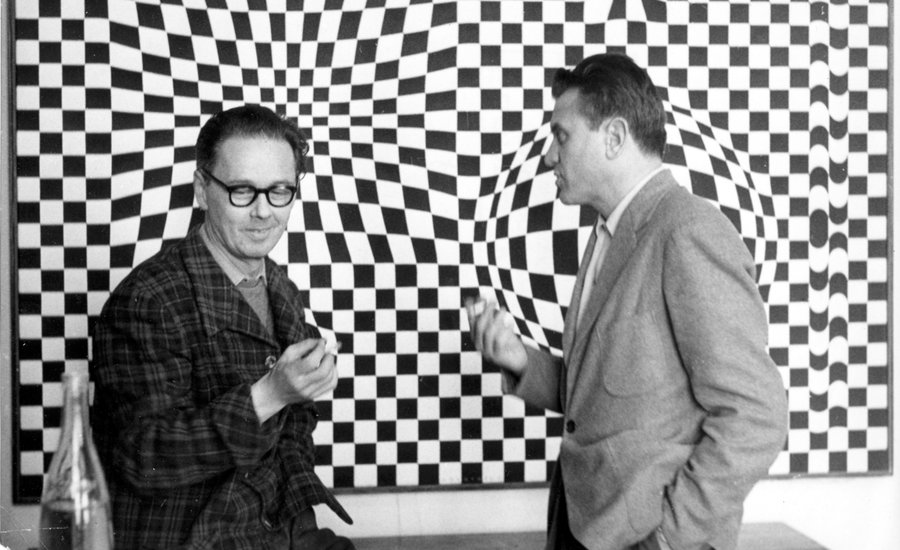
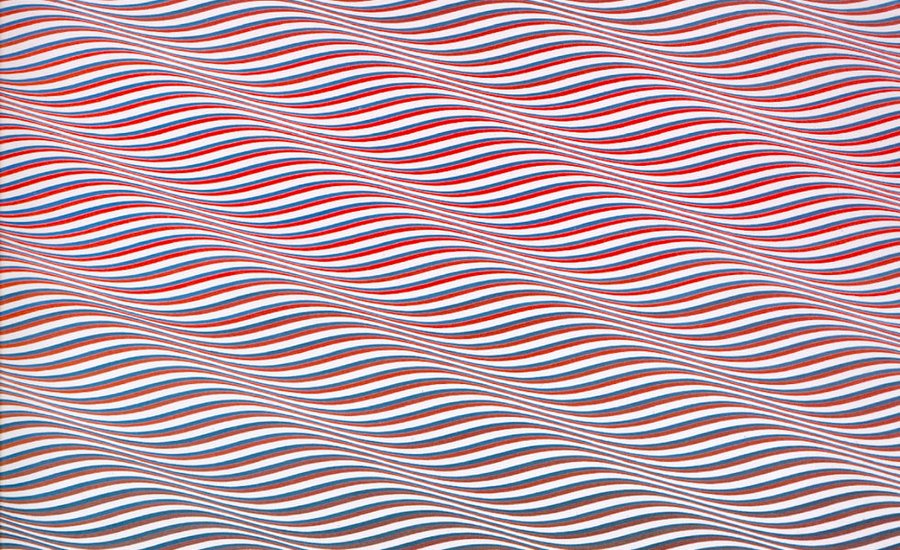 Cataract 3 by Bridget Riley, 1967
Cataract 3 by Bridget Riley, 1967 Bridget Riley's Fall, 1963
Bridget Riley's Fall, 1963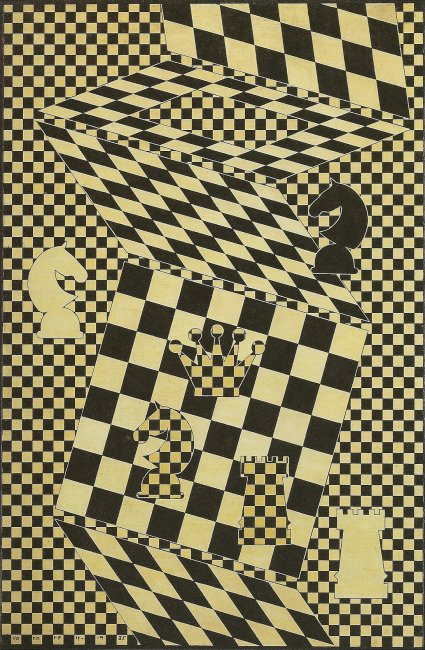 The Chess Board by Victor Vasarely, 1935
The Chess Board by Victor Vasarely, 1935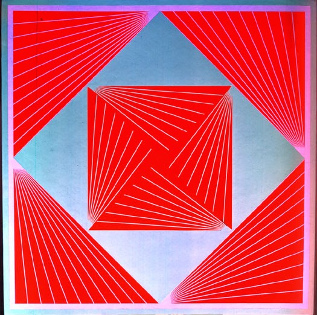 Intrinsic Harmony by Richard Anuszkiewicz, 1965
Intrinsic Harmony by Richard Anuszkiewicz, 1965